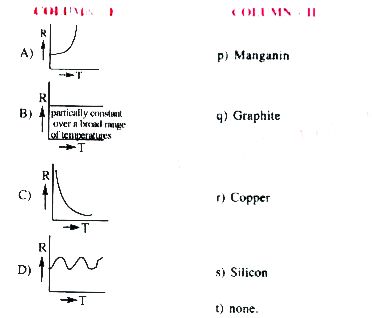Is the temperature reading more in activity (i) or (ii)?
To determine whether the temperature reading is more in activity (i) with water or activity (ii) with sand or soil, we can follow these steps:
1. Understand the Activities:
- Activity (i): A beaker full of water placed in sunlight for 3 hours.
- Activity (ii): A beaker full of sand or soil placed in sunlight for 3 hours.
2. Concept of Specific Heat:
- Specific heat is the amount of heat energy required to raise the temperature of a substance by 1 degree Celsius.
- Water has a high specific heat, meaning it requires more energy to increase its temperature compared to other substances like sand or soil.
3. Energy Exposure:
- Both beakers (water and sand/soil) are exposed to the same amount of sunlight for the same duration (3 hours). This means they receive approximately the same amount of energy.
4. Temperature Increase:
- Due to its high specific heat, water will absorb more energy without a significant increase in temperature.
- In contrast, sand or soil, with a lower specific heat, will absorb the same amount of energy and experience a greater increase in temperature.
5. Conclusion:
- After 3 hours of exposure to sunlight, the temperature of the sand or soil (activity ii) will be higher than that of the water (activity i) because sand or soil heats up more quickly due to its lower specific heat.
Final Answer:
The temperature reading is more in activity (ii) with sand or soil.
---
- Activity (i): A beaker full of water placed in sunlight for 3 hours.
- Activity (ii): A beaker full of sand or soil placed in sunlight for 3 hours.
- Specific heat is the amount of heat energy required to raise the temperature of a substance by 1 degree Celsius.
- Water has a high specific heat, meaning it requires more energy to increase its temperature compared to other substances like sand or soil.
- Both beakers (water and sand/soil) are exposed to the same amount of sunlight for the same duration (3 hours). This means they receive approximately the same amount of energy.
- Due to its high specific heat, water will absorb more energy without a significant increase in temperature.
- In contrast, sand or soil, with a lower specific heat, will absorb the same amount of energy and experience a greater increase in temperature.
- After 3 hours of exposure to sunlight, the temperature of the sand or soil (activity ii) will be higher than that of the water (activity i) because sand or soil heats up more quickly due to its lower specific heat.
The temperature reading is more in activity (ii) with sand or soil.
Topper's Solved these Questions
- BOOK - NCERT ENGLISHCHAPTER - NATURAL RESOURCESEXERCISE - EXERCISE20videos
NATURAL RESOURCES
- BOOK - NCERT ENGLISHCHAPTER - NATURAL RESOURCESEXERCISE - Questions1videos
NATURAL RESOURCES
- BOOK - NCERT ENGLISHCHAPTER - IMPROVEMENT IN FOOD RESOURCESEXERCISE - Exercise26videos
IMPROVEMENT IN FOOD RESOURCES
- BOOK - NCERT ENGLISHCHAPTER - THE FUNDAMENTAL UNIT OF LIFEEXERCISE - All Questions18videos
THE FUNDAMENTAL UNIT OF LIFE
Similar Questions
Optimum temperature is the temperature at which organism's life activities
View SolutionWhat is the influence of temperature on enzyme activity?
View SolutionWhat happes to most probable to the absolute temperatur and the energy of activation with increase in temperature ?
View SolutionRead the following statements regarding muscle contraction
(i) One ATP utillised for making and breaking of the cross bridge.
(ii) The sarcomere lies between 2 Z-lines
(iii) Troponin blocks the active sites in resting stage
(iv) Ca++ ions help in unmasking active sites on HMM
Choose the correct optionView SolutionThere are two Cu spheres having same size. One of them is hollow and the other one is solid. Which will expand more if
(i) they are heated through same temperature range.
(ii) they are supplied with same amount of heat.View SolutionEstimate the average thermal energy of a helium atom at (i) room temperature (27∘C) (ii) the temperature on the surface of the sun (6000K), (iii) the temperature of 10 million kelvin (the typical core temperature in the case of a star)
View SolutionWhich of the statement is/are true about the reactivity of halogenation of alkanes ? The reactivity ordar is F2>C12>Br2>I2 .
I. Lower the activation energy for the chain initiation step, more reactive is the halogen.
II. Lower the activation energy for the first chain propagation step, more reactive is the halogen.
III. More negative is the overall heat of the reaction (ΔH∘r) of halogenation ofg alkane, more reactive is the halogen.
IV. Lower the activation energy for the second chain-propagation step, more reactives is the halogen.View SolutionWhich of the following reaction characteristics change on addition of a catalyst to a reaction at constant temperature ?
(i) Activation energy ltbr> (ii) Equilibrium constant
(iii ) Gibbs enregy change
(iv ) enthylpy change of reactionView SolutionEach figure in Column - I shows the variation of resistance with temperature. Some materials are mentioned in Column - II. Match Column - I with Column - II.
 View Solution
View Solution.......... of molecules containing more than activation energy is indicated by Boltzmann's curve
View Solution

